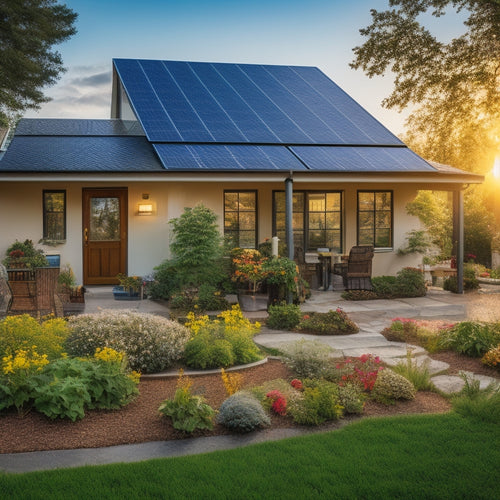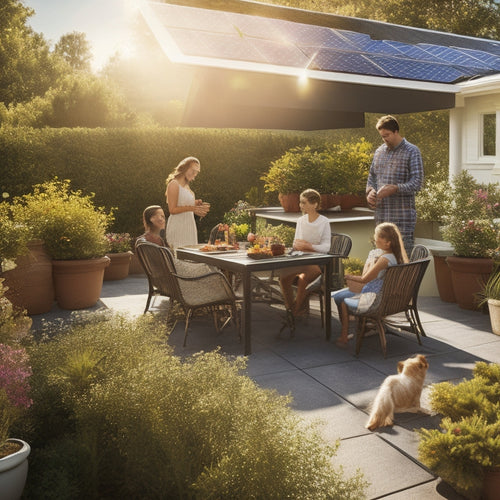
Irrigation Power: 7 Ways to Harness Renewable Energy
Share
You're already taking an important step towards reducing your irrigation system's carbon footprint by considering renewable energy sources. Solar power, in particular, can efficiently power your irrigation systems while reducing your reliance on fossil fuels and lowering operating costs. By integrating solar energy into your farm, you can increase control over energy costs and promote healthy soil conditions. With energy storage systems, you can guarantee a steady power supply. Ahead, explore seven strategies for harnessing renewable energy to optimize your irrigation system, and discover the benefits that come with it.
Key Takeaways
• Implement solar-powered irrigation systems to reduce reliance on fossil fuels and lower operating costs.
• Conduct energy audits to identify areas of inefficiency and optimize energy usage in irrigation systems.
• Integrate energy storage systems with solar panel installations to ensure a consistent energy supply for irrigation.
• Adopt smart irrigation controllers and variable frequency drives to optimize water usage and reduce energy waste.
• Strategically plan and maintain solar panel installations to maximize energy generation and reduce environmental impact.
Solar Power for Irrigation Systems
As the world shifts towards sustainable agriculture practices, you're likely considering solar power for your irrigation systems, and rightly so, as it can greatly reduce your reliance on fossil fuels and lower operating costs.
By harnessing solar energy, you can power your irrigation systems efficiently, reducing your carbon footprint and contributing to water conservation efforts. Solar farms can be designed to meet your specific energy needs, providing a reliable source of power for your irrigation systems. This not only helps reduce your environmental impact but also increases your control over energy costs.
Reducing Energy Costs With Renewables
When exploring methods to decrease energy costs for your irrigation system, you'll want to contemplate implementing energy efficiency strategies that optimize your energy usage.
You can also take advantage of renewable energy incentives that offer financial benefits for switching to clean energy sources.
Energy Efficiency Strategies
How can you optimize your irrigation system's energy consumption by leveraging renewable energy sources and cutting-edge technologies to reduce your energy costs and environmental footprint?
Conducting energy audits is an important step in identifying areas of inefficiency and opportunities for improvement. By evaluating your current energy usage, you can pinpoint where to implement changes that'll decrease your carbon footprint.
Implementing energy-efficient technologies, such as variable frequency drives and high-efficiency pumps, can greatly reduce energy consumption. Additionally, adopting smart irrigation controllers that adjust water application based on real-time weather data can optimize water usage.
Renewable Energy Incentives
You can greatly reduce your energy costs and environmental footprint by taking advantage of renewable energy incentives, which can help offset the upfront costs of installing solar, wind, or biogas-powered irrigation systems. These incentives can make your shift to renewable energy more affordable and increase your return on investment.
| Incentive Type | Description |
|---|---|
| Government Grants | Provide funding for renewable energy projects, often with no repayment required |
| Tax Credits | Offer a percentage of project costs as a credit against taxes owed |
| State Incentives | Vary by state, offering additional funding or tax breaks for renewable energy projects |
| Net Metering | Allow you to sell excess energy back to the grid and offset energy costs |
| Rural Energy for America Program | Provides grants and loan guarantees for rural renewable energy projects |
Harnessing Solar Energy for Farms
As you consider harnessing solar energy for your farm, you'll need to think about the logistics of solar panel installation, including the placement and maintenance of the panels.
You'll also need to plan for energy storage systems to guarantee a steady supply of power, even on cloudy days or at night.
Solar Panel Installation
Solar panels can be installed on farms to generate electricity, reducing reliance on non-renewable energy sources and minimizing the carbon footprint of irrigation systems.
As you consider solar panel installation, keep in mind the following essential steps:
-
Energy Audits: Conduct an energy audit to determine your farm's energy needs and identify areas for improvement.
-
Panel Maintenance: Regularly inspect and maintain your solar panels to guarantee peak energy production and extend their lifespan.
-
Best Placement: Strategically position your solar panels to maximize energy generation, taking into account factors like shade, orientation, and roof size.
Energy Storage Systems
To guarantee a consistent and reliable energy supply for your farm's irrigation systems, integrating energy storage systems with your solar panel installation is crucial. This ensures that excess energy generated during the day can be stored for later use, providing grid resiliency during periods of high energy demand or grid outages.
You'll need to contemplate battery maintenance to ensure peak performance and extend the lifespan of your energy storage system. Regularly check and maintain the battery's state of charge, temperature, and voltage to prevent degradation. By doing so, you'll maximize your energy independence and reduce reliance on the grid.
With a well-designed energy storage system, you'll have peace of mind knowing your irrigation systems will continue to operate smoothly, even when the grid is down.
Irrigation System Integration
Your farm's irrigation systems can now be seamlessly integrated with your solar panel installation, allowing you to harness the full potential of renewable energy to power your irrigation needs. This integration enables you to optimize your water usage, reducing your reliance on non-renewable energy sources. By doing so, you'll not only decrease your carbon footprint but also improve your water quality.
Here are three key benefits of integrating your irrigation system with solar energy:
-
Increased water efficiency: Solar-powered irrigation systems can optimize water usage, reducing waste and conserving this valuable resource.
-
Improved land use: By leveraging solar energy, you can repurpose land previously dedicated to traditional energy infrastructure, increasing your farm's productivity.
-
Enhanced water quality: By reducing your reliance on non-renewable energy sources, you'll minimize the environmental impact of your irrigation system, preserving water quality for future generations.
Efficient Water Management Solutions
Optimizing irrigation systems with advanced technologies and precision farming techniques enables farmers to conserve water and reduce energy consumption. By leveraging these innovations, you can implement efficient water management solutions that minimize waste and maximize crop yields.
For instance, precision irrigation systems use real-time data and sensors to monitor soil moisture levels, ensuring that crops receive the exact amount of water needed. This approach not only conserves water but also reduces energy consumption.
Additionally, crop monitoring technologies allow you to track crop health and growth, enabling data-driven decisions that optimize water usage. By adopting these solutions, you can achieve significant water conservation while maintaining peak crop yields.
Environmental Benefits of Solar Irrigation
In addition, by incorporating solar-powered irrigation systems, you can greatly diminish your carbon footprint and alleviate the environmental impacts linked with traditional fossil fuel-based irrigation methods. Solar irrigation reduces greenhouse gas emissions, contributing to carbon sequestration and mitigating climate change.
Additionally, it preserves ecosystems by minimizing pollution and protecting biodiversity.
Here are three key environmental benefits of solar irrigation:
-
Reduced air pollution: Solar power eliminates the emissions generated by traditional fossil fuel-based irrigation methods, improving local air quality and public health.
-
Water conservation: Solar irrigation promotes efficient water management, reducing waste and conserving this precious resource.
-
Ecosystem preservation: By reducing pollution and preserving natural habitats, solar irrigation helps maintain ecosystem balance and promotes biodiversity.
Implementing Solar Panels for Agriculture
To guarantee a seamless integration of solar power into your agricultural operations, you'll need to carefully assess your energy requirements and select the appropriate solar panel configuration for your irrigation system. Consider factors like water pumping requirements, energy storage needs, and system monitoring capabilities.
| Irrigation System | Solar Panel Configuration | Benefits |
|---|---|---|
| Drip Irrigation | 10 kW, 30 panels | Increased water efficiency |
| Sprinkler Irrigation | 20 kW, 60 panels | Reduced energy costs |
| Micro-Irrigation | 5 kW, 15 panels | Enhanced crop monitoring |
| Flood Irrigation | 30 kW, 90 panels | Integration with farm robotics |
| Precision Irrigation | 15 kW, 45 panels | Real-time crop monitoring |
Boosting Crop Yields With Clean Energy
Clean energy integration into your agricultural operations can greatly enhance crop yields and quality, allowing you to reap the benefits of sustainable farming practices. By leveraging renewable energy, you can optimize your irrigation systems, reduce water waste, and promote healthy soil conditions.
Here are three ways clean energy can boost your crop yields:
-
Efficient Irrigation: Solar-powered pumps can provide a reliable and consistent water supply, ensuring your crops receive the right amount of water at the right time.
-
Crop Rotation: With clean energy, you can implement crop rotation strategies that promote soil conservation, reduce erosion, and increase biodiversity.
-
Precision Farming: Renewable energy can power precision farming tools, enabling you to monitor and adjust soil conditions, temperature, and moisture levels to create an ideal growing environment.
Frequently Asked Questions
Can I Use Renewable Energy for Irrigation in Areas With Limited Sunlight?
You can still utilize renewable energy for irrigation in areas with limited sunlight by leveraging wind potential and energy storage systems, allowing you to harness power when it's available and use it when needed.
Are Government Incentives Available for Farmers Using Renewable Energy?
As you cultivate a greener future, imagine harvesting government incentives alongside your crops. You'll reap the benefits of tax credits and policy changes, designed to nourish your renewable energy investments and cultivate a sustainable agricultural landscape.
How Do I Maintain and Clean My Solar Panels for Optimal Performance?
You'll maintain peak solar panel performance by regularly inspecting for dust accumulation, ensuring panel efficiency isn't compromised. Use water conservation methods for cleaning, and perform routine panel inspections to prevent energy loss.
Can I Use Renewable Energy to Power My Existing Irrigation System?
"You're already ahead of the game, considering a renewable energy upgrade for your existing irrigation system. Start with an energy audit to assess your system's efficiency, then explore options for a seamless Irrigation Upgrade, and get ready to reap the benefits of sustainable power."
Are There Any Financing Options Available for Renewable Energy Installations?
You can explore financing options for your renewable energy installation, including grants available for agricultural projects and tax breaks that can help offset the upfront costs, making your sustainable switch more affordable.
Related Posts
-

How to Achieve Energy Independence at Home
To achieve energy independence at home, start by investing in renewable energy sources like solar panels, wind turbin...
-

Long-Term Cost Savings With Solar Panels
Investing in solar panels offers substantial long-term savings on energy costs. You'll benefit from federal tax credi...
-

Solar Inverter Troubleshooting for Beginners
Troubleshooting your solar inverter starts with understanding its efficiency and performance metrics. Check for prope...


